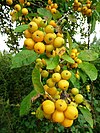
Malus is a genus of about 30–55 species of small deciduous trees or shrubs in the family Rosaceae, including the domesticated orchard apple – also known as the eating apple, cooking apple, or culinary apple. The other species are commonly known as crabapples, crab apples, crabtrees, or wild apples.

Malus floribunda, common name Japanese flowering crabapple, Japanese crab, purple chokeberry, or showy crabapple, originates from Japan and East Asia. It may be a wild species, or a hybrid of M. sieboldii × M. baccata.
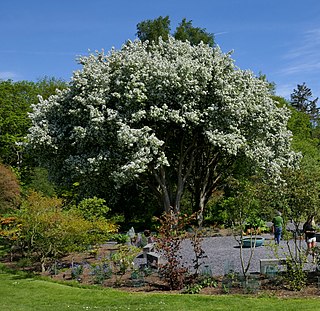
Malus hupehensis, common names Chinese crab apple, Hupeh crab or tea crabapple, is a species of flowering plant in the apple genus Malus of the family Rosaceae.

Malus fusca, with the common names Oregon crabapple and Pacific crabapple, is a North American species of crabapple.

Malus angustifolia, or southern crabapple, is a species of crabapple native to the eastern and south-central United States from Florida west to eastern Texas and north to New Jersey, Pennsylvania, Illinois and Missouri.

Malus florentina is a species of apple known by the common names Florentine crabapple and hawthorn-leaf crabapple. It is native to the Balkan Peninsula and Italy, and it is grown elsewhere as an ornamental tree.
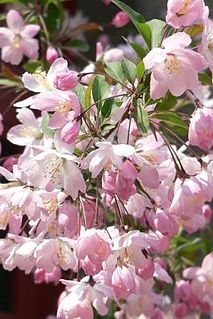
Malus halliana is an East Asian crabapple species of Malus, known by the common name Hall crabapple. Its Chinese name is chui si hai tang(垂丝海棠).

Malus ioensis, or the prairie crabapple, is a species of crabapple tree native to the United States. The most common variety, Malus ioensis var. ioensis, is found primarily in the prairie regions of the upper Mississippi Valley. Another variety, Malus ioensis var. texana, or the Texas crabapple, is found only in a small region of central Texas.

Malus prattii is a crabapple species, endemic to China.
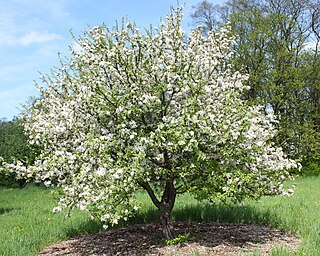
Malus prunifolia is a species of crabapple tree known by the common names plumleaf crab apple, plum-leaved apple, pear-leaf crabapple, Chinese apple and Chinese crabapple. It is native to China, and is grown elsewhere for use as an ornamental tree or as rootstock. It reaches from between 3 and 8 meters tall and bears white flowers and yellow or red fruit.

Malus sieboldii, commonly called Siebold's crab, Siebold's crabapple or Toringo crabapple, is a species of crabapple in the family Rosaceae.

Malus spectabilis is a species of crabapple known by the common names Asiatic apple, Chinese crab, and Chinese flowering apple.

Malus transitoria, the cut-leaf crabapple, is a species of flowering plant in the crabapple genus Malus of the family Rosaceae, native to China.

Malus yunnanensis is a species in the genus Malus, family Rosaceae, with the common name Yunnan crabapple. In Mandarin Chinese, it is called “滇池海棠”.

The Maleae are the apple tribe in the rose family, Rosaceae. The group includes a number of plants bearing commercially important fruits, such as apples and pears, while others are cultivated as ornamentals. Older taxonomies separated some of this group as tribe Crataegeae, as the Cydonia group, or some genera were placed in family Quillajaceae.

Malinae is the name for the apple subtribe in the rose family, Rosaceae. This name is required by the International Code of Nomenclature for algae, fungi, and plants, which came into force in 2011 for any group at the subtribe rank that includes the genus Malus but not either of the genera Rosa or Amygdalus. The group includes a number of plants bearing commercially important fruits, such as apples and pears, while others are cultivated as ornamentals.
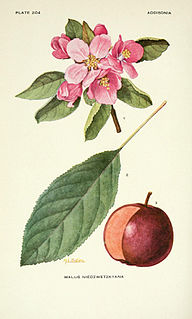
Malus niedzwetzkyana, or Niedzwetzky's apple, is a kind of apple native to certain parts of China, Afghanistan, Kazakhstan, Kyrgyzstan, and Uzbekistan noted for its red-fleshed, red-skinned fruit and red flowers. Some botanists consider it a distinct species, while others have argued it is simply an unusual variety of the common apple, Malus pumila.
Applecrabs are various hybrids between crabapples and apples. They are bred for varying reasons, including disease resistance and use in cold climates because they are often hardier than apple trees and their fruit has the good eating qualities of apples.

Malus PERPETU 'Evereste' is an ornamental cultivar of crabapple that has been developed by INRA in 1974 and is registered under their trademark with the name Malus perpetu.
Cut-leaf crabapple is a common name for several plants and may refer to:




















